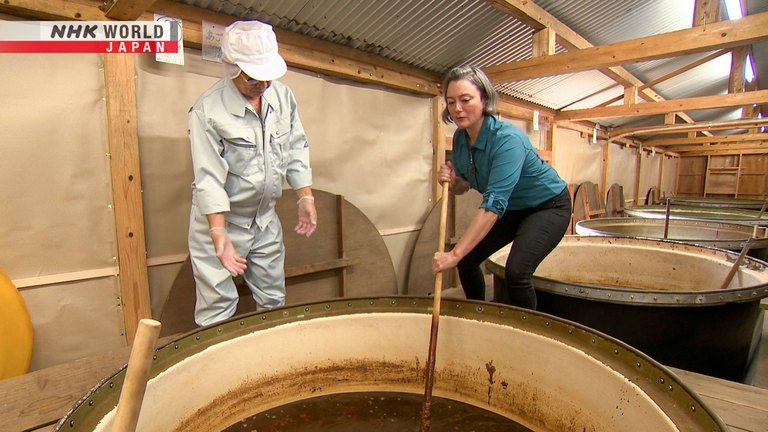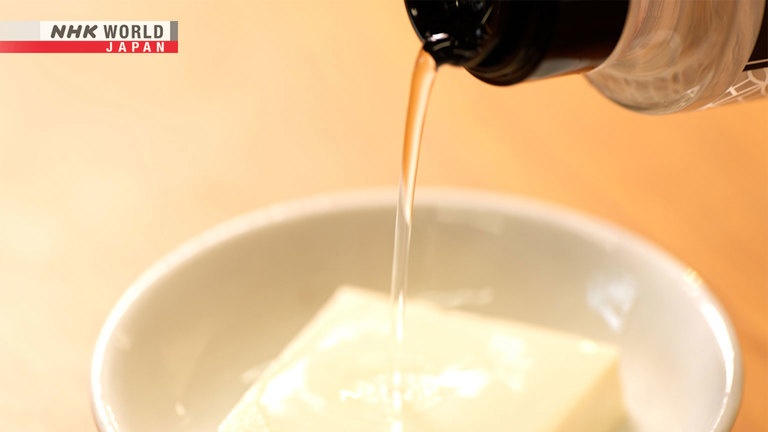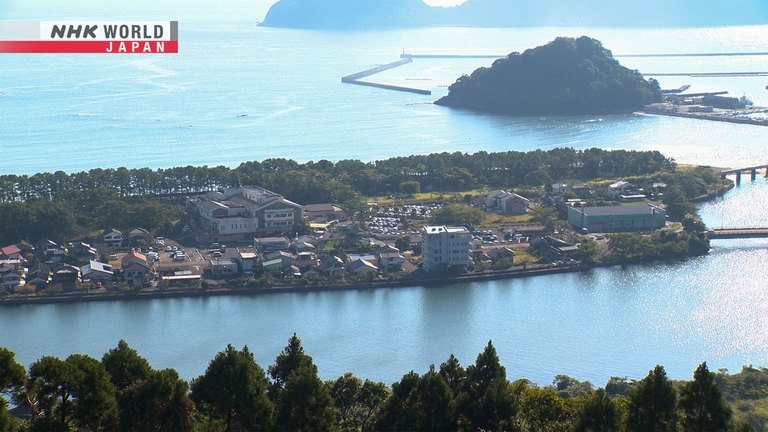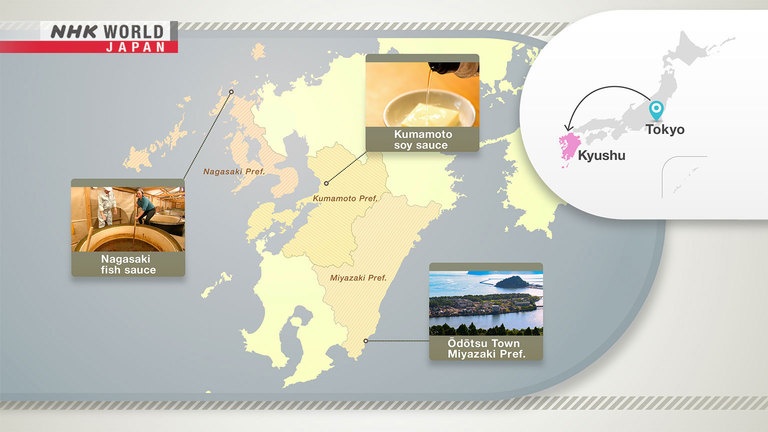Kyushu: On the Trail of Shoyu Nagasaki – Kumamoto – Miyazaki
Soy sauce, or shoyu, is one of the essential seasonings that underpin Japanese cuisine. In Kyushu (southwestern Japan), various types of soy sauce have been developed to complement different dishes. From one region to the next, each sauce has its own tradition and use. This has led to the creation of numerous sauces across the region, including new kinds of shoyu featuring a range of ingredients.
Nagasaki Fish Shoyu

A new style of "fish" shoyu that offers all the nutrients of seafood but with the flavor of soy sauce. In recent years a growing number of producers in Nagasaki Prefecture have begun making similar types of "fish shoyu."
Kumamoto Soy Sauce

A traditional soy sauce producer in Kumamoto Prefecture has also been developing new ideas, such as a clear (transparent) shoyu.
Ōdōtsu, Miyazaki Prefecture

This port town in Nichinan City has a long reputation as a center for brewing soy sauce. Despite its small population of about 1,400, there are still three shoyu producers in Ōdōtsu.
Access

To reach Nagasaki from Tokyo, flights take two hours. From there, you can travel to Kumamoto and Miyazaki by ferry or by train.
Transcript
"Journeys in Japan"
Take a look at this view. It's incredible, isn't it?
We're here in Nagasaki, Kyushu.
The reason why we're here in Nagasaki is because we're going to try the different Kyushu soy sauces.
Soy sauce in Kyushu is sweeter than other parts of Japan,
and each region has its own unique variation.
And as we head from here down south, we're going to try those different variations
and I know I'm definitely going to enjoy it.
Soy sauce - or "shoyu" - is one of the essential seasonings that underpin Japanese cuisine.
It's made from soybeans and roasted wheat inoculated with a "kōji" mold starter.
Salt and water are added, and the mixture is then left to ferment.
After being aged for a time, this thick slurry is pressed, to extract the rich, dark liquid.
In Kyushu, southwestern Japan,
various types of shoyu have been developed, for complementing different dishes.
From one region to the next, each sauce has its own tradition and use.
Colleen is a radio DJ from the US who's lived in Fukuoka for 18 years.
On this edition of "Journeys in Japan,"
she visits various areas of Kyushu to sample the local sauces.
She gets to see for herself the way they're made...
There's kind of, like, mold?
And discovers their distinctive flavors and traditions.
It has a punch, but it's good.
Kyushu: On the Trail of Shoyu
Nagasaki - Kumamoto - Miyazaki
Colleen's journey starts in Nagasaki City, about 1,000 kilometers west of Tokyo.
From there, she continues to Kumamoto City;
and then to the town of Ōdōtsu in Miyazaki Prefecture.
Before Japan opened to the world in the mid-19th century,
Nagasaki was the only point of contact for traders from Europe.
To this day, it still has an exotic feel to it.
Several hundred years ago, when foreigners came to Japan,
it was this island that they stayed on.
And apparently there's something to do with soy sauce, or soy-sauce-related items here,
which is why we're here right now, and I'm going to learn a little bit about it today.
Hello.
You must be my guide. I'm Colleen.
Nice to meet you.
Let's go inside.
Thank you.
What a cool outfit!
This is what the gatekeepers used to wear.
In those days, people entering Dejima had to have a special pass.
The gatekeepers checked those passes.
I see.
This open-air museum recreates what the island of Dejima looked like.
This was where the merchants from Portugal and the Netherlands were required to stay.
This is amazing.
It shows the whole of Dejima.
This is what Dejima looked like, back in the Edo period.
It's an artificial island that was built in 1636 to house the Portuguese traders.
Although they were merchants, they also brought Christianity with them.
The government kept the Portuguese here, to prevent them spreading their religion.
-To keep them on a short leash.
-Exactly.
One major export from Japan in those days was copper.
It was shipped around the world, for use in making coins and other products.
Why was copper in demand?
Copper from Japan was valued for its high level of purity.
There's another display that catches Colleen's eye.
These look like old-style beer or "sake" bottles.
These bottles were used for shipping soy sauce abroad.
Amazing.
In those days, Japanese soy sauce spread as far as Europe.
That was their name for shoyu.
"Japanese soya."
Even centuries ago,
Japanese shoyu was highly prized in Europe for its rich flavor as a seasoning.
This recreation of a trader's warehouse shows some of the merchandise that was imported.
All those sacks. What was in them?
An important item: sugar.
In those days, Dejima was said to be so full of sugar
it was known as the "Sugar Island."
Japan had raw sugar made from sugarcane.
But it didn't have the knowhow to refine it, so the Dutch brought in white sugar.
Thanks to this abundance of sugar,
a wide range of sweet confections came to be developed in Kyushu.
Shoyu in Kyushu is sweeter than soy sauce in other regions.
Is that due to all the imported sugar?
Yes. The sugar imported in Nagasaki is one reason why the shoyu was sweetened.
That makes sense, huh?
Hirado is Nagasaki Prefecture's main production center for soy sauce.
Colleen visits a local store to see what kind of sauces are made in the city.
So, I want you to take a look at this.
If you look here, we've got soy sauce from this area, but it goes all they way from here... to here.
And there's so many different kinds of soy sauces,
but they're all also from different companies - not just one maker.
Nearly 40 types of sauce are produced in Hirado.
People here use different varieties, depending on what kind of dish they're eating.
In recent years, a new type of sauce has been developed in Nagasaki.
Instead of soybeans, it's made from another ingredient…
Hello.
I've come to have a look. My name is Colleen.
Come in.
Excuse me.
This is our shoyu cellar.
We leave it here to ferment and mature.
For the past 20 years, this company has also been producing a sauce similar to shoyu
but not made from soybeans.
We mix it up like this every day.
This draws fresh air to the sauce at the bottom of the tank.
Aerating it helps to improve the taste.
It looks like you're stirring in the flavor.
We think of shoyu as something that's alive.
In Japan, shoyu is traditionally made from grain.
But this one is made from fish.
Fish.
Nagata Masatoshi's company started out producing packets of dried fish
for making "dashi" soup stock.
But these bags are usually thrown away without using all the nutrients.
It occurred to him that he could use the same powdered fish
to make a nutritious sauce.
Fish contains many nutrients that are essential for our health.
I make this shoyu so that people can get 100% of the goodness of fish.
His aim is to imbue the sauce with the full goodness of the whole fish.
That was his reason for starting to make his "shoyu."
This is super fresh shoyu.
So, it's not sweet. It actually tastes kind of like what I had growing up.
Saltier.
But like... I don't know how to explain it.
It's a really good, like, punch in the mouth.
Um, it's really good. Um...
Yeah, I don't quite know how to explain it, though. But it's not fishy at all.
You don't taste the fish. Just delicious.
Nagata hopes this new type of shoyu will bring people good health.
The city of Kumamoto developed as a prosperous castle town.
It's also known for its abundant groundwater -
enough to supply 100 percent of its water requirements.
And I guess it's because Kumamoto has such delicious and clean water
that they're able to make really delicious soy sauce,
and that's what I'm going to go try here in Kumamoto.
Colleen's next stop is a local soy sauce producer.
Hello.
I've come here to have a tour.
My name's Yamamura. Pleased to meet you.
This company has been in business for a century and a half.
In terms of output, it's the largest shoyu producer in the prefecture.
This is our brewing chamber.
Oh my gosh. Wow!
There's so many tanks!
There are 48 tanks in here.
This is where we make the "kiage", the base for our shoyu.
This one's empty. Take a look inside.
It's really deep.
How deep is it?
About 4 meters.
Each tank holds about 70,000 liters of soy sauce.
The soy sauce here is prepared using the mineral-rich ground water.
It's left to ferment for six months.
Have a look at the ceiling. What do you think this is?
I don't know, I mean...
It's a little bit dirty, it looks like.
It might look like dirt, but they're actually microorganisms.
These microorganisms have been preserved since our brewery was founded in 1869.
After we moved here in 1973, we couldn't produce soy sauce for two years.
There weren't enough of the microorganisms.
Old timbers from the previous dismantled warehouse were brought into the new facility
and the microorganisms were allowed to propagate.
After two years, the soy sauce made there was back up to the previous standard.
When the fermentation is finished, the sauce is extracted here.
Although the equipment is modern,
the way the shoyu is pressed follows the same procedure as in the old days.
It's spread out on a cloth and then covered with another layer.
This step is repeated until dozens of layers are stacked up on top of each other,
and the liquid seeps out slowly and naturally.
Come this way.
Wow! There's everything in here.
All our products are here.
While continuing its traditional production methods,
this company is also developing new sauces.
This is our clear shoyu.
Soy sauce?
Using a dark shoyu can spoil the appearance of some dishes.
This sauce adds depth of flavor, while keeping the color.
That's soy sauce.
It's tasty.
I like this one.
Thank you very much.
It's tangy but, it's a little bit... kind of a smooth taste.
It's great that you're taking on new challenges.
Thank you.
Soy sauce consumption in Japan is declining along with people's changing tastes.
Even so, we believe soy sauce has lots more potential.
That's amazing.
Hello.
I'd like something that goes well with the local soy sauce.
How about "basashi"?
It tastes great with our sweet Kumamoto shoyu.
I'll go for it.
I'm really keen to try it.
The practice of eating basashi - or "sashimi" horse meat -
dates back to the days of the samurai.
Once, during a time of famine, the local warlord was served this dish,
and was amazed how good it tasted.
These days, it's become a Kumamoto delicacy.
Just a little bit.
It's got a lot of the fat. You can see the marbling in it.
But it's not heavy at all.
The soy sauce is just a little bit sweet,
so it kind of gives it a refreshing, smooth flavor.
And really the fat just melts in your mouth.
With that sweet soy sauce and it just kind of goes...
...on your tongue, and it's just so delicious.
Here, the horse meat has been prepared as sushi.
-This is delicious.
-Thank you.
The basashi was delicious, but this is even tastier.
The sweetness of the horse meat and the refreshing flavor of the vinegared rice...
It's a great combination with the shoyu.
I see.
Colleen's last dish is seafood sashimi.
The fish here is all caught in the waters off Kumamoto.
Is this the same sauce as the one you served with basashi?
This one is a bit saltier.
It brings out the flavor of the fish.
I'm going to go for the squid first.
And look at that. Like, it's just so beautifully cut there.
Fish has its own sweetness, so the saltier shoyu is a good match.
Whatever the ingredient, there's a sauce to complement its flavor.
So I've really enjoyed my education today, and it was a delicious education.
So we're here in Ōdōtsu.
It's quite a cute little station that we've got here, and
a very local place - really different from the other places I've been to.
But apparently, they do a lot of soy sauce brewing here.
So that's what we're here for, so we're going to check it out.
The town of Ōdōtsu sits on a narrow spit of land between the sea and a river.
It's gained a reputation as a soy sauce-producing town.
It has three shoyu breweries,
even though it has population of only about 1,400.
Colleen visits a local store to find out what kind of soy sauce is produced here.
We've got the "katsuo" - that's bonito.
And it's right here and it looks really delicious.
I see you have fish for sashimi. Do you have soy sauce?
Yes, we do.
We have shoyu from Ōdōtsu's three producers.
How are they different? Do you change the sauce for each food?
We like sweeter soy sauce for sashimi.
We use saltier sauces for simmered dishes.
Generally speaking, people around here prefer to use sweet soy sauce.
Thank you.
Colleen has bought some fresh bonito fish.
Now she's heading for a local shoyu producer.
It looks like we've got a soy sauce brewery here,
so I think I'm going to go and take a peek inside.
This company has been in business for 220 years.
It's the oldest of the three shoyu breweries in Ōdōtsu.
Oh, we have lots of soy sauce already.
Hello.
Could you show me around?
Sure.
I'd like to find out about soy sauce.
I'm Colleen.
My name's Miyata.
Miyata Kenya is the eighth-generation owner of this family brewery.
He has a workforce of six to help him with production.
Ōdōtsu is a small town with only 1,400 residents. How come it has three shoyu producers?
There are a number of reasons. One is that salt was produced here.
Ōdōtsu has long been a hub for shipping.
Soybeans and wheat were readily available, along with the local salt.
Everything was in place for producing shoyu.
Another factor is that Ōdōtsu is a port town, with many fishermen.
So shoyu was in great demand.
Fishermen like to eat the fish they catch while they're still out on their boats.
Because shoyu is easy to carry and brings out the "umami" of the fish,
that makes it the perfect seasoning.
I'd like to taste your soy sauce. I've brought some fish with me.
-May I eat it here?
-That's fine.
That's quite a lot.
For bonito, you need plenty of shoyu.
Won't it be too salty?
Will that be alright?
It's OK.
OK.
Let's see how it tastes.
Here goes.
I've just eaten it. So sometimes the bonito can be a little bit fishy.
And like he said, I've just dipped it in and like really dipped it,
so I was a little bit worried it would be too salty.
But it's not salty at all. It's kind of sweet, and...
It really complements the fish
and it wasn't even a fishy kind of taste, which was really nice.
Bonito is an oily fish, so you need plenty of soy sauce.
Also, using lots of soy sauce adds extra nutrients.
These are the factors underlying Ōdōtsu's history as a center for shoyu production.
However, in recent years this proud tradition has been declining.
Some 15 years ago there were five shoyu breweries in Ōdōtsu.
Now there are just three.
For a time, Miyata left his hometown to find work.
But he came home five years ago to take over the family business.
He didn't want Ōdōtsu to lose any more of its long lineage.
My mission is to preserve the tradition that has been passed down since the old days.
It would be a shame to let it die out.
How do you see the future of shoyu from Ōdōtsu?
I believe our sweet shoyu can spread through Japan.
And I think it can also win fans abroad.
Ōdōtsu has a long history as a center for shoyu production.
As long as there are people who value this and want to preserve it,
that tradition will live on.
So, we've been on this trip to discover the different variations of soy sauce in different regions of Kyushu.
And I've had the chance to taste those different variations, but
what I noticed even more was the tradition, the determination, and the creativity
and the variations in that within the different makers that we met on this trip.
And I want to invite you to come and experience those variations for yourself.
Not only the flavors, but also among the people.
To reach Nagasaki, flights from Tokyo take two hours.
From there, you can take a ferry or train to travel to Kumamoto and Miyazaki.